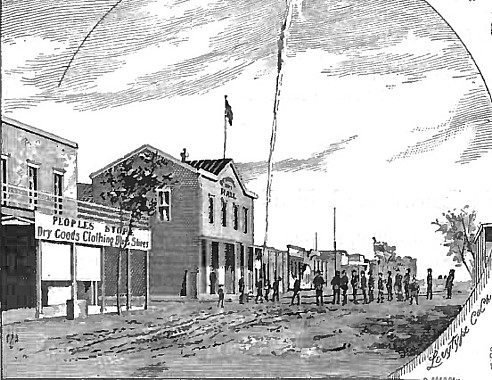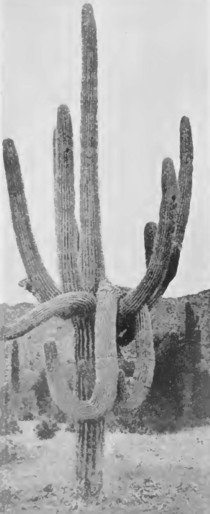HARSHAW DISTRICT
The Harshaw mining area joins on the north that part of the Patagonia
District which extends across the range. The district extends northward to
the Sonoita River, at Patagonia, its western boundary following closely the
crest of the mountains, the formation of the two districts presenting the
same general characteristics. It includes some of the most noted and notable
mines in Southern Arizona, including the
Hardshell, Hermosa, World's Fair, Trench, Wieland Group, Blue Nose,
Jefferson, Sunnyside, Buffalo Group, Chief Group, Great Silver Mine, and
many more. At the present time active operations are conducted in a number
of those named.
The Hermosa Mine was operated in the early '80's by a New York Company which built a 20-stamp mill, that produced a deal of silver bullion. At that time the record of production was more than a million dollars within eighteen months, and later it produced another half million. It is believed to contain yet a great deal of valuable mineral, well worth exploitation. The Hardshell, which is adjacent to the Hermosa, has also a great record of production. Upon the property there is a concentrating mill. After a period of idleness extending over a number of years, the property has been taken over recently by experienced mining men, who will renew the history of the mine. The World’s Fair mine is one of the most noted and valuable properties in the district, with a long record of production. The property lies about two miles west from Harshaw. The location was made in 1879, and at that time considerable high-grade ore was shipped. In 1884 the property passed by purchase to Frank and Josephine Powers, the consideration said to have been $100. It is reported that within a few months the purchasers had extracted and shipped several 25-ton carloads of rich rock that yielded from $8,000 to $25,000 per carload. Shipments were made, however, only when money was needed, and from ores taken out in development. In 1903 it was estimated that such development had exposed, ready for stoping and shipment $600,000 worth of high-grade lead and silver ores. The owners have been content to let the values remain in the ground, as a safer place than bank vaults; and the property has never been exploited to swell a plethoric bank account; yet, according to statistical information, in 1907 the production was $74,210 in ores yielding lead, copper, gold and silver. During 1910 the production was $42,730.82. There has been production every year, and since its discovery in 1879 the World's Fair is said to have produced more than one million dollars.
It was in operation for many years, and there were extracted many tons of high-grade ore, rich in lead, silver, gold and copper. The World's Fair is developed to a depth of 600 feet, and it is the deepest mine in the district. The underground workings measure about 15,000 feet of tunnels, drifts, shafts, stopes and winzes. The main entrance is a crosscut tunnel at an altitude of 4,680 feet. In this tunnel is a winze 600 feet deep, with 1 ,000 feet of drifting each way, the development following the vein, with levels 100 feet apart. There is a good equipment of machinery, including a 10-stamp mill. However, there has been little use for that, the rich ores bearing shipment to points where cost of reduction is much lower. The country rock is diorite intruded with rhyolite, and the ore deposits seem associated with the lines of contact between the two kinds of rock. The average width of the vein is about six feet, and it is filled with high-grade rock. In the upper workings the ores were generally lead-silver ; but below the water level the usual law of the region prevails, copper coming into the combination with some antimonial silver and high values in gold ore. The average values are said to run 20 per cent copper, 500 ounces silver, and $15 per ton in gold. There have been made a number of offers to purchase, and there have been some negotiations, but without result. The sales price set by the owners is one million dollars, 10 per cent in hand without inspection of the property. North from the World's Fair mining camp, about a mile, there lies the other "Red Hill," or porphyry copper ore deposit mentioned elsewhere, that promises the foundation for a great producer of the red metal. Beside the great mass of porphyritic rhyolite in the mountain, there are many mineralized veins and dykes, from some of which good shipping ores are taken. In the Aztec Group, on the north side of the hill, not far south from Patagonia, there occurs such a vein; and on the east side of the hill there are others, in the Hardtmayer claims and in the properties of Wagner & Fessler. Northeast from the World's Fair, about a mile, is The Basin, a region that holds in a great hollow a cluster of good mines, including the Wieland Group, Buffalo Group, Red Men, Great Silver Mine, and several others, in various stages of development, some of them shipping ores at the present time.
PALMETTO DISTRICT
The palmetto mining district lies on the west side of the Patagonia
Mountains, between the Harshaw and Nogales Districts, extending northward
from the Patagonia District to the Sonoita River. From east to west its
width is about four miles, and the length is six. The topography is rough,
and on the east side of the district the contour rises abruptly from an
altitude of about 4,500 feet to one exceeding 6,000 feet, the summit of the
highest being about 6,400 feet above sea level. The country rocks embrace
diorite,
quartz; monzonite, rhyolite and
granite
porphyry, the second in the list
predominating. The mineral deposits lie in the eastern part of the district,
and they are associated closely with those found in the Harshaw District
adjacent on the east, many of the properties in the two districts being in
juxtaposition, notably the World's Fair and Chief in the Harshaw District,
and the Flux and R. R. R. in the Palermo District.
The ores comprise lead, silver and copper. The lead silver ores occur in the quartz monzonite, and the copper is found in the granite porphyry and sedimentary rocks. In some cases the lead-silver ores carry a little native gold, silver and molybdenum. The principal mines in the district are the Flux, Domino, R. R. R., Jarilla, New Hope, Palmetto, Sonoita, Arizona-European, Grey Brothers, Dos Amigos, and others. The most noted and most important, in point of development, are the R. R. R. mines, which attracted great attention some three years ago on account of magnitude, richness and great value of the copper deposits encountered; and the development thereof gave to mining in the surrounding region an impetus which marked a new era in the affairs of Santa Cruz County, but which was checked by a protracted litigation between the original owners of the property, litigation that is still in the appellate court, and has caused a suspension of operations with cancellation of a bond and lease under which the property was in operation. In the holdings of the R. R. R. Group there are included fifty or more good claims. They lie on the west side of the main range of the Patagonia Mountains, about four miles south from the town of Patagonia, just below the crest of the ridge, at altitudes ranging from 5,500 to 4,000 feet. The ground rises abruptly, giving excellent opportunity for development by tunnels, which is the system employed, there being four, from 200 to 600 feet in length, with a shaft 375 feet deep. The entire development embraces several thousand feet of tunnels, shaft, crosscuts, winzes, etc., and as developed the ore body gives 700 feet of backs. A wagon road from the entrance of the lowest tunnel to the railway station at Bloxton, 3/4 miles away, which is the shipping point, gives excellent facility for hauling the ore to a railway. Between May, 1911, and October, 1914, ore shipments are said to have reached a total exceeding one million of dollars in value, the shipments continuing at the rate of 100 tons of good ore daily. The rock is said to have averaged 9 per cent copper. The ores are chalcocite, chalcopyrite and pyrite, with occurences of galena and cerussite. The country rock is mainly a granite-porphyry, and the ore deposits occur in a shear zone traversing those rocks. At this writing the litigation pending in the Supreme Court of Arizona has been argued, a decision is due at any time, and when it is given it is to be hoped that the litigous owners will be able to make a composition by which operations can be resumed.
In the immediate vicinity of the R. R. R. the Flux Mine is in operation, a concentrating mill reducing the ores, and the concentrates are shipped. The mine and mill are connected by an aerial tramway. The property, owned and operated by the Sterling Development Company, has a record of production antedating the Civil War. The Jarillas Mine, near the south end of the district, the property of Messrs. E. E. Bethell, of Patagonia; Bracey Curtis and Doctor A. L. Gustetter, of Nogales, is in active operation and presents considerable development. The ore is high grade, carrying lead, silver and gold. Shipments made some years ago yielded $5,000, giving returns of 40 per cent lead, 175 ounces silver and 1 ounce gold per ton. Of course, it is understood that the properties mentioned in these descriptions of the various districts are but a few of those worth giving attention. To give a very short description of all would extend this bulletin to a large volume.
Return
to The Arizona Page:
Arizona Gold Rush Mining History



